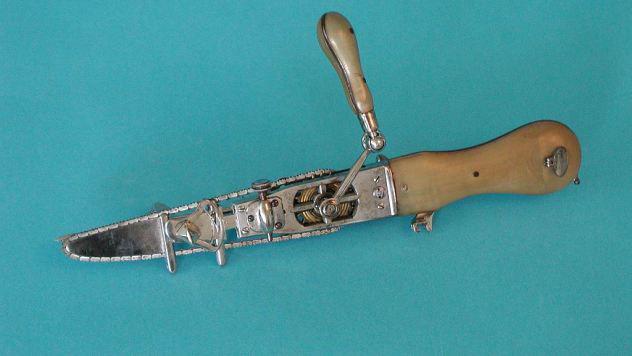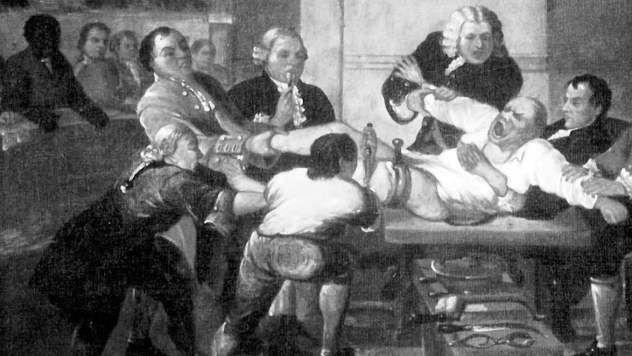827
The most horrific medical tools of the past (10 photos)
Stem cell research, printed in 3D bodies and genetically modified viruses - we live in a world that our ancestors could not even imagine. We have forgotten to what monstrous bloated small by today's problems, before the invention of anesthesia. Yes, and the type of medical instruments themselves could come to dread:

Osteotome

In essence, this is a chain saw, but it is only intended for cutting of trees is not. Initially, this tool invented by Bernard Heine, about 1830, was used in trepanation, and later he began to apply variations in the amputation of limbs and even dental surgery.
The tool for stretching the urethra

When the urethra is narrowed so that the patient man could not write properly, doctors resorted to the help of this tool. He was introduced to the urethra through the tip of the penis to the problem areas.
Then, the screw handle is turned to separate the two elements, and the channel extend as far as possible, often tearing the tissue. And pouring out the blood was considered a good sign.
The simulator for dentists

This aluminum structure is used in the 1930s to train future dentists. Apparently, it was on top of a rubber coating that mimics the human head, but it was lost. The simulators are usually inserted teeth, pulled out the corpses.
Incubators lice

This is not a medical instrument, but we have included this piece in our list, because it has helped to create a vaccine and saved many lives.
During the wars of diseases claim more lives than actually fighting. Epidemic typhus could mow the whole army, not to mention the poor urban areas where large numbers of people huddled in small rooms and unsanitary conditions prevailed.
The disease is transferred lice, from which there was no escape until the 20-ies of the last century, when Professor Rudolf Wagle invented a method of producing an effective vaccine. Lice specially grown, feeding on the blood of people who are called the "breadwinners" - for this cell parasites were attached to the legs or hips. Adult lice infested, then cut and created a vaccine.
Guillotine for tonsils

Before the advent of antibiotics, any, the most innocent in our opinion the infection can lead to tragic consequences. In order to cure tonsillitis and avoid associated complications such as peritonsillar abscess (or purulent tonsillitis), and was invented by this device.
Dr. amygdala pierced with a fork and cut the blade of the guillotine. This device proved a great relief for doctors, as before they were forced to go into the patient's mouth with your fingers, and often suffered from bites.
Hemorrhoidal forceps

The most popular method of hemorrhoid treatment was to remove the damaged portions. This tool is gripped external hemorrhoid to stop the blood flow. Damaged tissue as a result were white and die. Internal hemorrhoids first angling with special hooks, and then either burned or cut with scissors.
Litotes

The stones in the urinary bladder were always common problem, especially among poor families, which are included in the diet of insufficient protein.
In these cases, doctors usually made perineal incision to reach the bladder. And then comes the turn of lithotomy. The tool has been equipped with two contiguous blades that appeared at the right time of the guide sheath incised and expanded base of the bladder. The surgeon then take forceps and tried to pull the stones that when viewed felt through the wall of the rectum.
Not wanting to prolong the meal of their patients in the pre-anasteziynuyu era, doctors tried to keep within five minutes.
A loop to remove tissue

To remove the hemorrhoids, and other growths - tumors, polyps, cysts, etc., using this tool here. Sometimes at the end of the loop was equipped with sharp teeth, sometimes it was an ordinary wire, which main purpose was not so much to cut, how to block the flow of blood. Once the loop is provided on the basis of tumors, the doctor began to tighten the screw, tightening it all the more. Similar instruments used for veterinarians castration of cattle.
Dental key

As oral health was on the most primitive level, and about the true causes of tooth decay and gum disease people have a vague idea, a toothache tormented our ancestors often. Hoping to somehow relieve it, and fled to the doctor, or, at worst, a local barber.
Before the invention of the early 18th century key dental, tooth extraction is done by brute force. And if during the operation the tooth was broken, the doctor removed the root together with a piece of gum using a bone chisel.
Dental key allows you to capture and hold an aching tooth, and then, swinging and twisting, pull it out of the gums - all, of course, without anesthesia. It is not surprising that people are trying to endure the toothache to the last.

Osteotome

In essence, this is a chain saw, but it is only intended for cutting of trees is not. Initially, this tool invented by Bernard Heine, about 1830, was used in trepanation, and later he began to apply variations in the amputation of limbs and even dental surgery.
The tool for stretching the urethra

When the urethra is narrowed so that the patient man could not write properly, doctors resorted to the help of this tool. He was introduced to the urethra through the tip of the penis to the problem areas.
Then, the screw handle is turned to separate the two elements, and the channel extend as far as possible, often tearing the tissue. And pouring out the blood was considered a good sign.
The simulator for dentists

This aluminum structure is used in the 1930s to train future dentists. Apparently, it was on top of a rubber coating that mimics the human head, but it was lost. The simulators are usually inserted teeth, pulled out the corpses.
Incubators lice

This is not a medical instrument, but we have included this piece in our list, because it has helped to create a vaccine and saved many lives.
During the wars of diseases claim more lives than actually fighting. Epidemic typhus could mow the whole army, not to mention the poor urban areas where large numbers of people huddled in small rooms and unsanitary conditions prevailed.
The disease is transferred lice, from which there was no escape until the 20-ies of the last century, when Professor Rudolf Wagle invented a method of producing an effective vaccine. Lice specially grown, feeding on the blood of people who are called the "breadwinners" - for this cell parasites were attached to the legs or hips. Adult lice infested, then cut and created a vaccine.
Guillotine for tonsils

Before the advent of antibiotics, any, the most innocent in our opinion the infection can lead to tragic consequences. In order to cure tonsillitis and avoid associated complications such as peritonsillar abscess (or purulent tonsillitis), and was invented by this device.
Dr. amygdala pierced with a fork and cut the blade of the guillotine. This device proved a great relief for doctors, as before they were forced to go into the patient's mouth with your fingers, and often suffered from bites.
Hemorrhoidal forceps

The most popular method of hemorrhoid treatment was to remove the damaged portions. This tool is gripped external hemorrhoid to stop the blood flow. Damaged tissue as a result were white and die. Internal hemorrhoids first angling with special hooks, and then either burned or cut with scissors.
Litotes

The stones in the urinary bladder were always common problem, especially among poor families, which are included in the diet of insufficient protein.
In these cases, doctors usually made perineal incision to reach the bladder. And then comes the turn of lithotomy. The tool has been equipped with two contiguous blades that appeared at the right time of the guide sheath incised and expanded base of the bladder. The surgeon then take forceps and tried to pull the stones that when viewed felt through the wall of the rectum.
Not wanting to prolong the meal of their patients in the pre-anasteziynuyu era, doctors tried to keep within five minutes.
A loop to remove tissue

To remove the hemorrhoids, and other growths - tumors, polyps, cysts, etc., using this tool here. Sometimes at the end of the loop was equipped with sharp teeth, sometimes it was an ordinary wire, which main purpose was not so much to cut, how to block the flow of blood. Once the loop is provided on the basis of tumors, the doctor began to tighten the screw, tightening it all the more. Similar instruments used for veterinarians castration of cattle.
Dental key

As oral health was on the most primitive level, and about the true causes of tooth decay and gum disease people have a vague idea, a toothache tormented our ancestors often. Hoping to somehow relieve it, and fled to the doctor, or, at worst, a local barber.
Before the invention of the early 18th century key dental, tooth extraction is done by brute force. And if during the operation the tooth was broken, the doctor removed the root together with a piece of gum using a bone chisel.
Dental key allows you to capture and hold an aching tooth, and then, swinging and twisting, pull it out of the gums - all, of course, without anesthesia. It is not surprising that people are trying to endure the toothache to the last.























